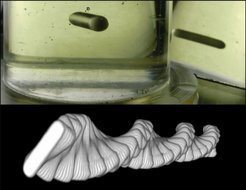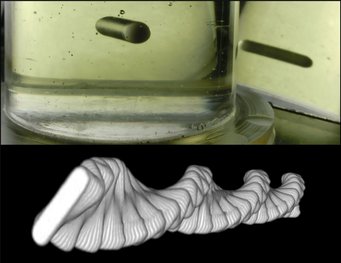Magnetic Stirrer Levitation: The Flight of the Humble Flea
Göttingen Max Planck scientist discovers an entirely new method of levitation

Top: Image of the levitating flea in Castor Oil. Bottom: A 3D spiral rendered by combining experimental images of the flea over a 1 s period as it levitates, demonstrating the dynamics of the levitating behaviour, which combines low frequency spinning and high frequency oscillation.
The new method uses a simple tool that most laboratories world-wide already possess: a magnetic stirrer, a device that employs a rotating magnetic field to cause a stirring bar immersed in a liquid to spin very quickly, thus mixing it. Since its invention in 1942, it has been known that if such a stirrer is driven too quickly, the stirring bar-magnet will hop erratically on the base of the container – hence its nickname „the flea“. MPIDS scientist Dr. Kyle Baldwin finds that if the viscosity of the liquid in a container is similar to that of honey, the flea stops hopping and instead jumps up and levitates within the liquid. „We stumbled upon this phenomenon whilst mixing high viscosity polymer solutions, and were fascinated,“ recalls Kyle, the first author of the paper. Alongside researchers from Nottingham, Kyle carefully analyzed the motion of the levitating flea in a large series of experiments and found that its motion is systematic. The stirring bar waggles back-and-forth, pumping fluid out to the sides, which experiment and simulations show stabilizes its position. Intriguingly, if the viscosity is reduced, the fluid is pumped in the opposite direction, and the flea falls.
„Our discovery should motivate the design of bi-directional fluidic pumps, improve understanding of effective swimming methods, and provide a new levitation route for container-less storage or friction-less transport", explains Dr. Baldwin. This fundamental discovery could be used in robotics and provide new opportunities in nano-technology and medicine, such as providing easily controllable artificial micro swimmers for a better diagnostic. New horizons that are being opened by the discovery are truly breath taking! However, it is still unlikely to make flying broomsticks a reality.
